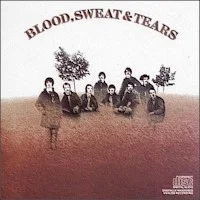Time: 45:28
Size: 104.1 MB
Styles: AM rock, Contemporary pop-rock, Jazz rock
Year: 1969/1989/2014
Art: Front
[ 2:27] 1. Variations On A Theme By Erik Satie (First Movement)
[ 5:06] 2. Smiling Phases
[ 3:08] 3. Sometimes In Winter
[ 3:04] 4. More And More
[ 4:03] 5. And When I Die
[ 5:51] 6. God Bless The Child
[ 4:04] 7. Spinniing Wheel
[ 4:17] 8. You've Made Me So Very Happy
[11:49] 9. Blues Pt 2
[ 1:35] 10. Variations On A Theme By Erik Satie (1st Movement-Adapted From 'trois Gymnopedies)
Recording Date: August 2, 1968 - October 22, 1968
The difference between Blood, Sweat & Tears and the group's preceding long-player, Child Is Father to the Man, is the difference between a monumental seller and a record that was "merely" a huge critical success. Arguably, the Blood, Sweat & Tears that made this self-titled second album -- consisting of five of the eight original members and four newcomers, including singer David Clayton-Thomas -- was really a different group from the one that made Child Is Father to the Man, which was done largely under the direction of singer/songwriter/keyboard player/arranger Al Kooper. They had certain similarities to the original: the musical mixture of classical, jazz, and rock elements was still apparent, and the interplay between the horns and the keyboards was still occurring, even if those instruments were being played by different people. Kooper was even still present as an arranger on two tracks, notably the initial hit "You've Made Me So Very Happy." But the second BS&T, under the aegis of producer James William Guercio, was a less adventurous unit, and, as fronted by Clayton-Thomas, a far more commercial one. Not only did the album contain three songs that neared the top of the charts as singles -- "Happy," "Spinning Wheel," and "And When I Die" -- but the whole album, including an arrangement of "God Bless the Child" and the radical rewrite of Traffic's "Smiling Phases," was wonderfully accessible. It was a repertoire to build a career on, and Blood, Sweat & Tears did exactly that, although they never came close to equaling this album. ~William Ruhlmann
The difference between Blood, Sweat & Tears and the group's preceding long-player, Child Is Father to the Man, is the difference between a monumental seller and a record that was "merely" a huge critical success. Arguably, the Blood, Sweat & Tears that made this self-titled second album -- consisting of five of the eight original members and four newcomers, including singer David Clayton-Thomas -- was really a different group from the one that made Child Is Father to the Man, which was done largely under the direction of singer/songwriter/keyboard player/arranger Al Kooper. They had certain similarities to the original: the musical mixture of classical, jazz, and rock elements was still apparent, and the interplay between the horns and the keyboards was still occurring, even if those instruments were being played by different people. Kooper was even still present as an arranger on two tracks, notably the initial hit "You've Made Me So Very Happy." But the second BS&T, under the aegis of producer James William Guercio, was a less adventurous unit, and, as fronted by Clayton-Thomas, a far more commercial one. Not only did the album contain three songs that neared the top of the charts as singles -- "Happy," "Spinning Wheel," and "And When I Die" -- but the whole album, including an arrangement of "God Bless the Child" and the radical rewrite of Traffic's "Smiling Phases," was wonderfully accessible. It was a repertoire to build a career on, and Blood, Sweat & Tears did exactly that, although they never came close to equaling this album. ~William Ruhlmann
Blood, Sweat & Tears

